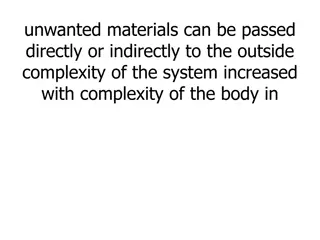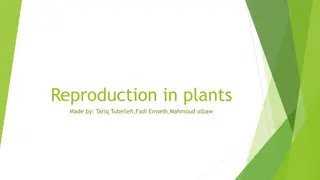Reproduction and Kidding Patterns of Astor Markhor in Gilgit-Baltistan
Astor Markhor, a subspecies of Capra falconeri falconeri, faces endangerment in its natural habitat across South and Central Asian countries. This study evaluates the reproduction and kidding patterns of Astor Markhor in Gilgit-Baltistan, focusing on gestation periods, rut seasons, and female maturity ages related to breeding cycles. The research sheds light on factors influencing reproductive success and population sustainability among these endangered mountain goats.
Download Presentation

Please find below an Image/Link to download the presentation.
The content on the website is provided AS IS for your information and personal use only. It may not be sold, licensed, or shared on other websites without obtaining consent from the author.If you encounter any issues during the download, it is possible that the publisher has removed the file from their server.
You are allowed to download the files provided on this website for personal or commercial use, subject to the condition that they are used lawfully. All files are the property of their respective owners.
The content on the website is provided AS IS for your information and personal use only. It may not be sold, licensed, or shared on other websites without obtaining consent from the author.
E N D
Presentation Transcript
AN ASSESSMENT OF REPRDUCTION AND KIDDING PATTERN OF ASTORE MARKHOR (capera falconeri falconeri) IN GILGIT BALTISTAN Submitted By Israr Hussain M.Phil Registration No.: 2019-KIU-7188 Session (2019-2021) Submitted To Dr. Muhammad Zafar Khan (Supervisor) Karakoram International University Gilgit Dr. Saeed Abbas (Co-Supervisor) International Union for the Conservation of Nature Pakistan __________________________________________________________________ Department of Environmental Science Karakoram International University Gilgit-Baltistan, Pakistan
Table of Content Introduction Research Problem Objectives of Study Significance of Study Justification of Study Material and Method Work plan
Introduction Astore markhor (Capra falconeri falconeri) belongs to the Carpinae group of the Bovidae family (Schaller, 1977; Roberts, 1977) were first described by Wagner in 1839 (Huffman, 2004). Five sub-species are reported from Pakistan, namely: Astore Markhor, Kashmir Markhor, Suleiman Markhor, Kabul Markhor and Bukhara Markhor and almost all are categorized as Endangered (IUCN, 2015). Markhor are found in the South Asian countries of Pakistan, India, and Afghanistan, and in the Central Asian countries of Turkmenistan, Tajikistan, and Uzbekistan (Schaller, 1977). Markhor have a wider distribution in Pakistan than in any other country (Hess et al., 1997). Markhor are social animals and live in small herds. The herds consist of females, their kids, yearlings and young males. Mature males live alone outside the herds and only join the herds during the winter rut season in late December (Roberts, 1977).
December is the rut season and it continues for one month up to January. According to Roberts (1977) gestation period is approximately six months while the age of maturity for reproduction of female in straight-horned markhor is about three years. Markhor are diurnal feeders and graze/browse mostly early in the morning and late in the evening. They can be seen feeding irregularly during winter throughout the day (Roberts, 1977). The age of maturity for reproduction for female in straight-horned markhor is about three years (Roberts, 1977) while for the female of flare-horned markhor, it is two years (Aleem and Malik, 1977).
In Gilgit the young are born at the end of May to early June which would indicate a gestation period of about 160 days. Similarly in Baluchistan the young are born early in April. Other authorities have given the gestation period as varying from 147 to 180 days (H. Vass, 1961; Walker et al., 1964). Haller (1992) were noticed that Lower female to kid ratio is probably due to higher mortality and predation on younger crop and may also be due to low reproduction and over harvest of productive males for trophies inside CMCAs (Khan, 2011 & Loveridge, 2006).
Khan et al. (2014) identified wider distribution of markhor in the Karakoram, Himalayas and encompassing Darel, Tangir, Chillas, Sakwar, Jutial, Barmas, Kargah, Rahimabad, Jaglote, Sikandarabad, Bunji, Asotre and Skardu districts of Gilgit-Baltistan. A total of 1071 animals including 331 males, 452 females, 273 yearlings and 15 kids were recorded from 09 valleys. Considerably, larger herds were sighted in community managed conservation areas of Skoyo-Karabathang-Basingo (SKB), Bunji, and Jutial but other significant populations were also reported from Danyore, Sikandarabad and Jaglote valleys. Rahimabad and Jaglote Goor are still considered to be the potential habitats of markhor. Hindu Kush mountain ranges
Trophy hunting is a significant wildlife management strategy in many countries of Asia, Africa, and Europe (Lechuga, 2001) that has resulted in a positive change in attitudes of local people towards wildlife, the active involvement of communities in natural resource projects, and the achievement of conservation goals (Lewis and Alpert 1997, Baker 1997a). Mountain ungulates around the world have been threatened by illegal hunting, habitat modification, increased livestock grazing, disease and development (Kulbhushansingh et al., 2012). Frisina et al. (2002) stated that various diseases are transmitted to markhor through domestic goats and sheep.
Research Problem Markhor is classified as endangered species by the IUCN, (2015).There are number of threats to this species that are poaching illegal hunting, and Habitat loss. In Gilgit Baltistan illegal hunting is one of the major threats to this species. So the least known species seek for special care for its survival and conservation. Presently, the knowledge is very limited about population dynamics of Astore markhor in GB, especially the information on reproduction and kidding is either very scanty or absent. More importantly, the Astore markhor populations which are fragmented and occur mostly in isolations due to the geographical barriers, it is very important to understand the current status of their reproduction. Secondly, some populations in GB are subject to trophy hunting. It has been widely recommended to monitor the population dynamics of the hunted species (Khan et al., 2019). Therefore the current study aims to assess the reproduction and kidding of Astore markhor in GB.
Objectives of the study The objectives of Study is following Asses the distribution and population dynamics of Astore markhor during kidding seasons; To determine the reproductive rates and kidding patterns; To explore management prescriptions for breeding populations of Astore markhor.
Significance of the Study The study will explore useful information about breeding populations of Astore markhor including distribution of kidding populations, reproductive rates, survival of kids, etc, which is quite useful to understand the overall population dynamics of Astore markhor in GB. In the long run it will be helpful for wildlife managers to prioritize their conservation actions across different areas of markhor distribution and future recommendations for trophy hunting allocations.
Justification of the study The present study proposed, because knowledge is very limited on population dynamics of Astore markhor. In the light of available literature it would a firt dedicated attempt to understand the kidding pattern of Astore markhor in GB. The results of this study could be useful to rectify the situation of management, especially after presentation of its results to the stakeholders i.e. Governmental departments, NGOs and local communities.
Material And Methods Study Area: GB (71-75 o N; 32-37 E; 70,332 , 72,971 km ) consists of towering snow-covered mountains, deep gorges and narrow valleys. The fast running streams ultimately drain into the River Indus. The Karakorum, Hindu Kush and Himalaya ranges knot in the center of GB and diverge in different directions. The Karakorum and Hindu Kush have northwestern and southwestern orientations, respectively. The east-west oriented Himalayas occupy southern parts of GB. The Himalayas receive more liberal precipitation during the summer and winter monsoon (mean annual precipitation = 180 cm). They are therefore greener, supporting Himalayan dry temperate mountain forest, sub-alpine and alpine forest (Champion et al., 1965). Northern parts (Karakorum and Hindu Kush) have scanty summer rains, thinner vegetation and greater wind and water erosion. Climatically, GB falls in temperate zone. Winter temperatures remain below freezing for most of the year. The human population (0.7 million) is concentrated in major towns along streams. Small human settlements, groups of family houses and nomadic camps are scattered throughout GB (Fakhar-i-Abbas et al., 2015).
Historically markhor are distributed in many areas of Gilgit Baltistan including Astore, Skardu, Gilgit, Ghizer, Diamer (Figure 1). The present survey will be conduct in four Districts of Gilgit Baltistan, namely; Astore, Gilgit, Diamar and Nagar).
Methodology The method is considered one of the reliable techniques worldwide for studying ungulate ungulates populations (Kulbhushansingh et al., 2012). The double-observer survey method uses the robust frame-work of mark recapture theory to estimate population size (Caughley, 1974). We divided survey team members into two groups (observer A and observer B). They will be asked to maintain the temporal distance throughout the survey without giving cue each other and 30 minutes of temporal separation will ensured between the observers. Both observers will use the binocular after covering the distance of the 100m to scan the whole area thoroughly, moving through the predetermined trails without indication for each other. During the survey if observer B finds the observer A , he will pause until the observer A disappears. We will use the GPS for the coordinates of the herd s location, binoculars and spotting scope for observation of herds. We wrote the finding on survey sheet, at the end of the day, both observers will compare their data either they observed the same herds or different herds to avoid double counting.
Analytical Approach Analytical Approach Population will be estimated by using Capture Mark- Recapture Method in (Specific MS Excel-2013 formats) based on the formulas (Forsyth and Hickling, 1997). Where: Where: B= Number of groups seen by both observers S1= Groups seen by observer first S2= Groups seen by observer second = Estimated number of groups = Mean Group size N= Estimated population 15
Statistical Analysis The data will be analyzed through descriptive statistics, presented in graphs and tables, the data analysis in SPSS (statistical Package for Social Sciences), T test were used to compute ratios among different sex and age Variance test deviation also apply for determine variation, also find Frequency distribution for all population (Female, Male, and Kids etc.) as well as determine relationship between Reproduction and Kids and compered ratio among sites of different districts. Geographical Information system (GIS) will be incorporated in the research for better results. Required Equipment's The required equipment's are following; i. Survey sheet ii. Gps iii. Binocular iv. Spotting scope v. Camera vi. Pen/notebook classes. and While, Standard
Work plan Time frame Experimental design, layout and execution 1 year Review of literature/ literature cited collection and management Data collection (kidding) Data collection (winter population and kids survival) Data tabulation April 2020 August-2020 December 2020 Septembar-2020 December-2020 Sep-Oct 2020 Dec 2020-Jan 2021 Data analysis Results/findings and their linkup with basic/ground theories Submission of 1st draft of thesis/ dissertation March 2021
The End If any Question?























